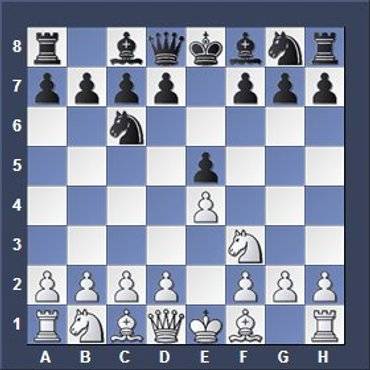To know chess notation helps you to read and replay chess games that you find in newspapers and in chess books. You should be able to replay games in order to see the position for real on your board.
It is hard to replay games in your head, some players can do this, but still you understand moves better if you see the position right in front of your eyes.
The easiest Chess Notation
I recommend you learn the Algebraic notation which is now standard among all chess organizations, it is also used in most books and newspapers. It is short, straightforward and clear.
You simply identify each square of the chessboard by a letter and a number.
Example: e4 – this means pawn goes to e4, that’s it.
The first moves of a game could be:
1. e4 e5 2.Nf3 Nc6 (See position below)

This means, at move 1, a pawn goes to e4, another pawn (Black moves) goes to e5.
These are very popular starting moves. (See position above)
Second move is: a knight (White) goes to f3 and a knight (Black) goes to c6. The N is used for Knight (stands for Nightrider) because we need the K for the king.
Each piece has its own uppercase letter.
N-Knight, B-Bishop, R-Rook, Q-Queen, K-King
The pawn has no letter, so we use the square coordinates only.
12.b3 f5 Meaning: White moved a pawn to b3, Black moved a pawn to f5.
Capture
If you capture a piece or a pawn you use x
For example: 3.Nxe – white Knight captures e-pawn at move three. In this game above it would be the senseless move Knight on f3 captures the black pawn on e5. After this Black would play NxN and White has lost a valuable knight for just one pawn. NxN means Knight captures Knight.
Castling
Short castling: 0-0
Long castling: 0-0-0
To give a Check
If you give a check add + to the piece that gives the check.
For example: 14. Ne5+ This means, at move fourteen a white knight is going to e5 and gives a check. This is the first “half-move”, so it must be White who has moved. It must be a white knight as White can move only white pieces. Simple logic.
To give a Double Check
If you give a double check add ++ to the piece that gives the double check.
Example: Ng5++
Disambiguating Moves
If there are two identical pieces which can move to the same square then you just add the letter of the square where it comes from, to clarify which piece has moved.
With knights on c3 and g3, one of the two has moved to e4. To clarify you write Nce4 or Nge4.
Examples:
23…Be4+ This means at move 23 a black bishop moves to e4 and gives a check. This must be a black bishop because it is the second half-move.
3…Rxf+ Meaning: a black rook is capturing the f-pawn and gives a check at the same time.
6.QxB+ Meaning: At move 6 the white queen captures black bishop and gives check at the same time.
12.0-0-0 Meaning: White castled long at move 12.
23. Bc3 0-0-0 Meaning: At move 23 white bishop moved to c3 and Black castled long afterwards.
End of Game
1:0 or 1-0 White won the game
0:1 or 0-1 Black won the game
1/2 A Draw, half a point each
Quality of Moves
Good Move: !
Example: BxN!
Very good Move: !!
Example: b4!!
Bad Move: ?
Example: Qb4?
Very bad Move (a blunder): ??
Example: Nb4??
Dubious Move: ?!
Example: Bb5+?!
In the game below you can see the chess notation. You also learn that it is not wise to grab material at all cost as this can ruin your position. White took all the material he could get but soon ran behind in piece development. He got overun in the center and lost through checkmate.
Replay and study the Chess Game
Flip Board: Press F-Key (or click e7 or d2 on top)
Back from – Chess Notation to – Chess Tips
Go to – Chess Strategies – Home
Get UNIQUE Chess Courses from Chess Grandmaster Igor Smirnov (Ukraine)! BIG DISCOUNT! Click here!

